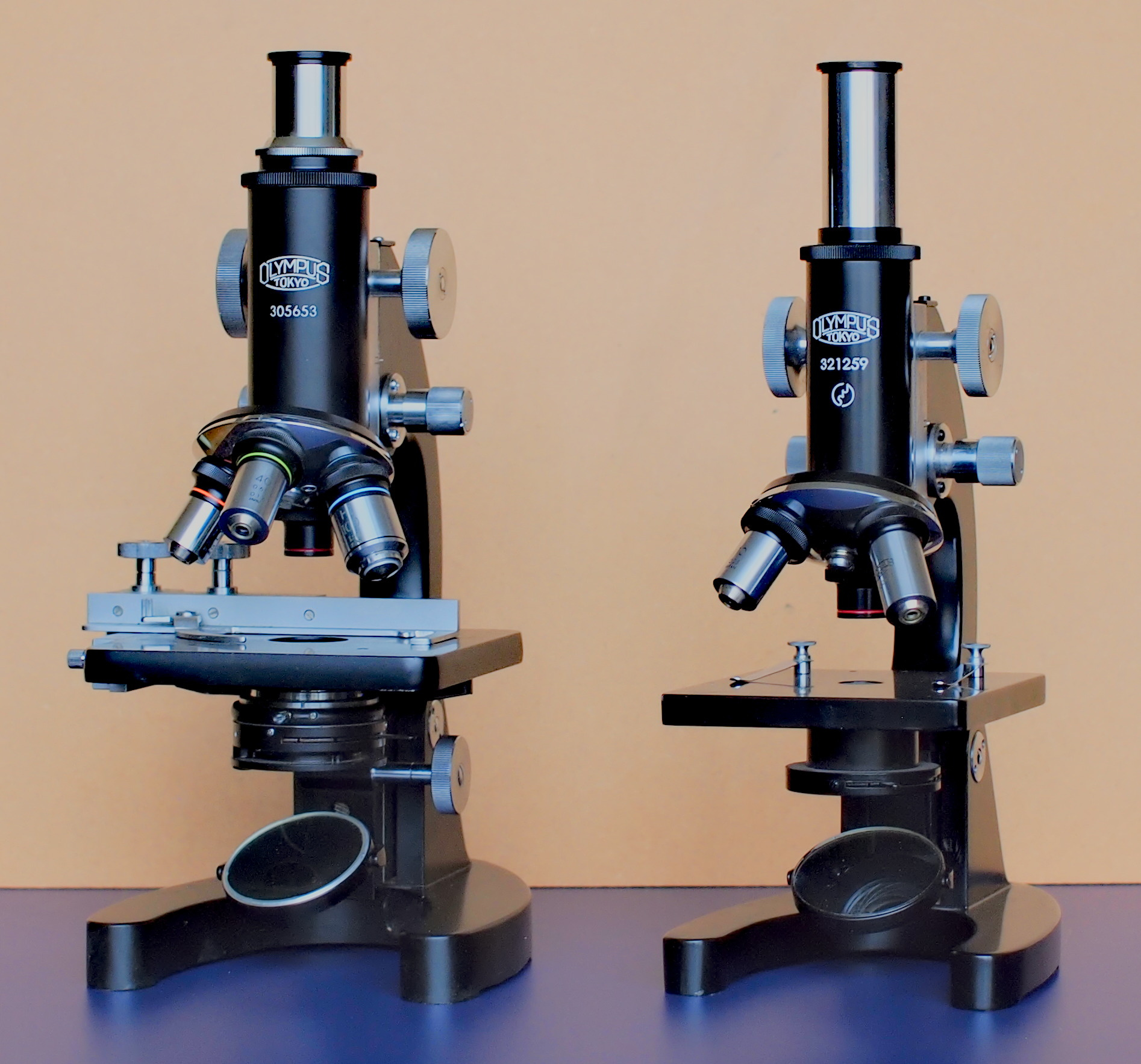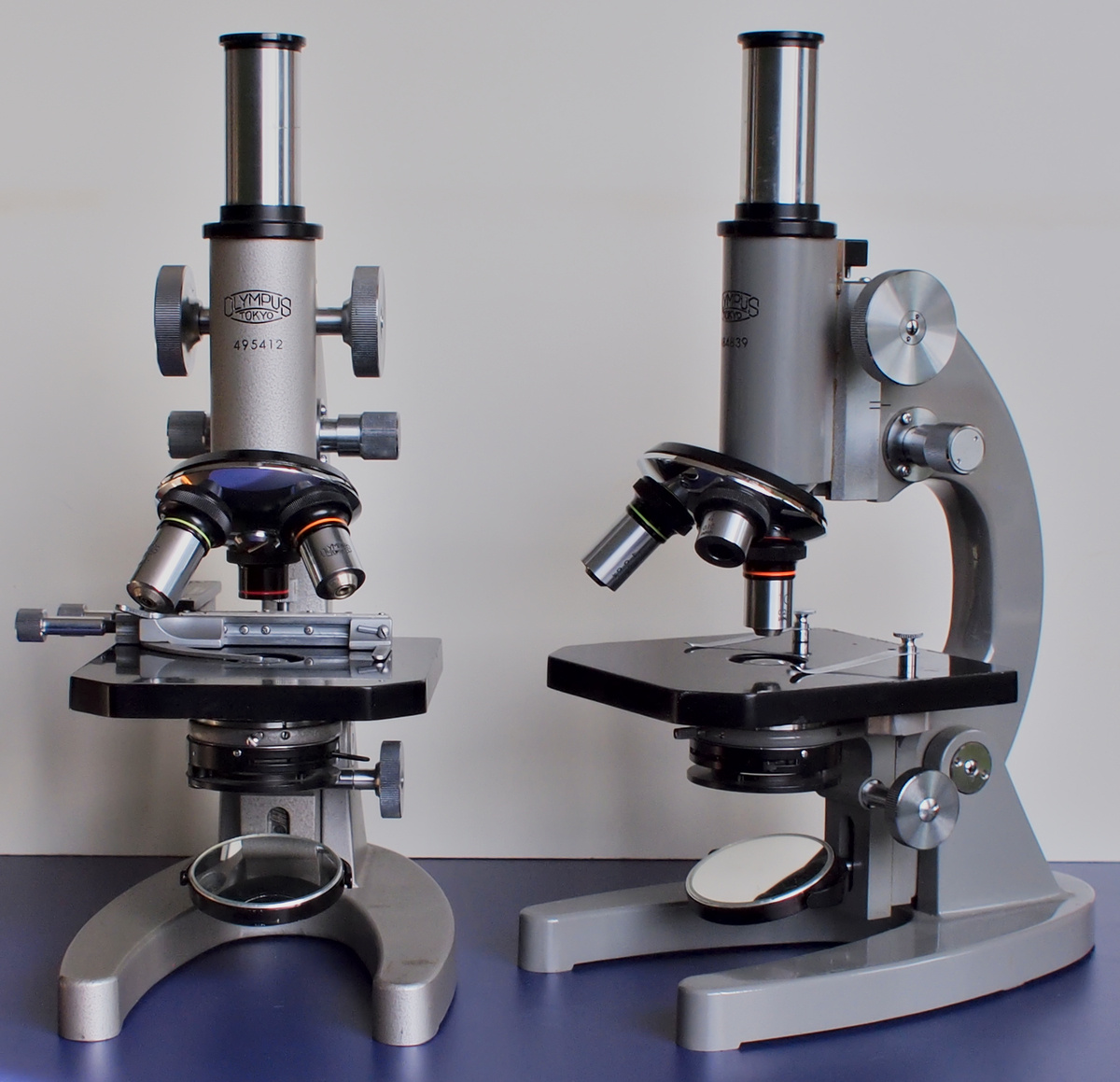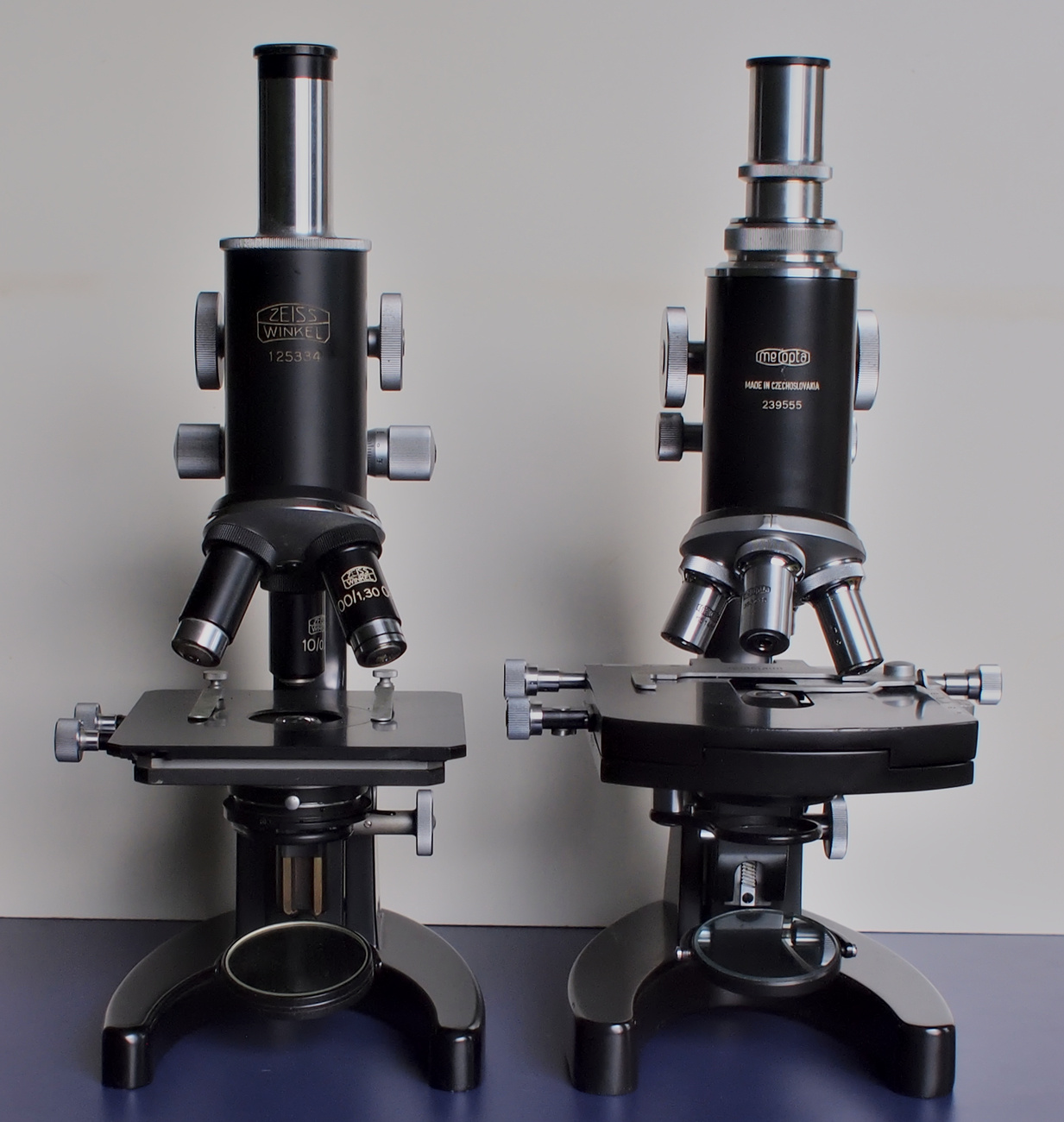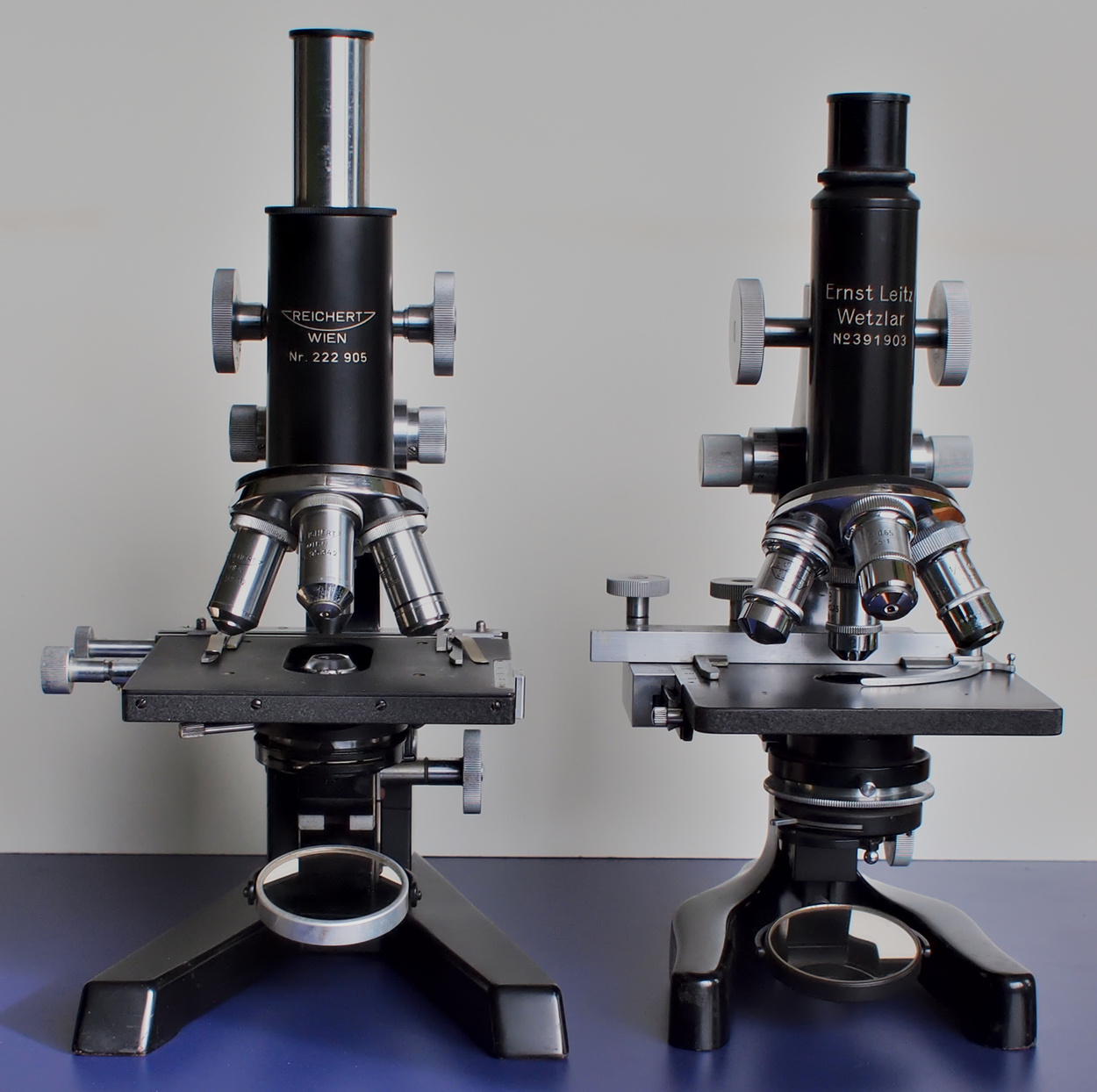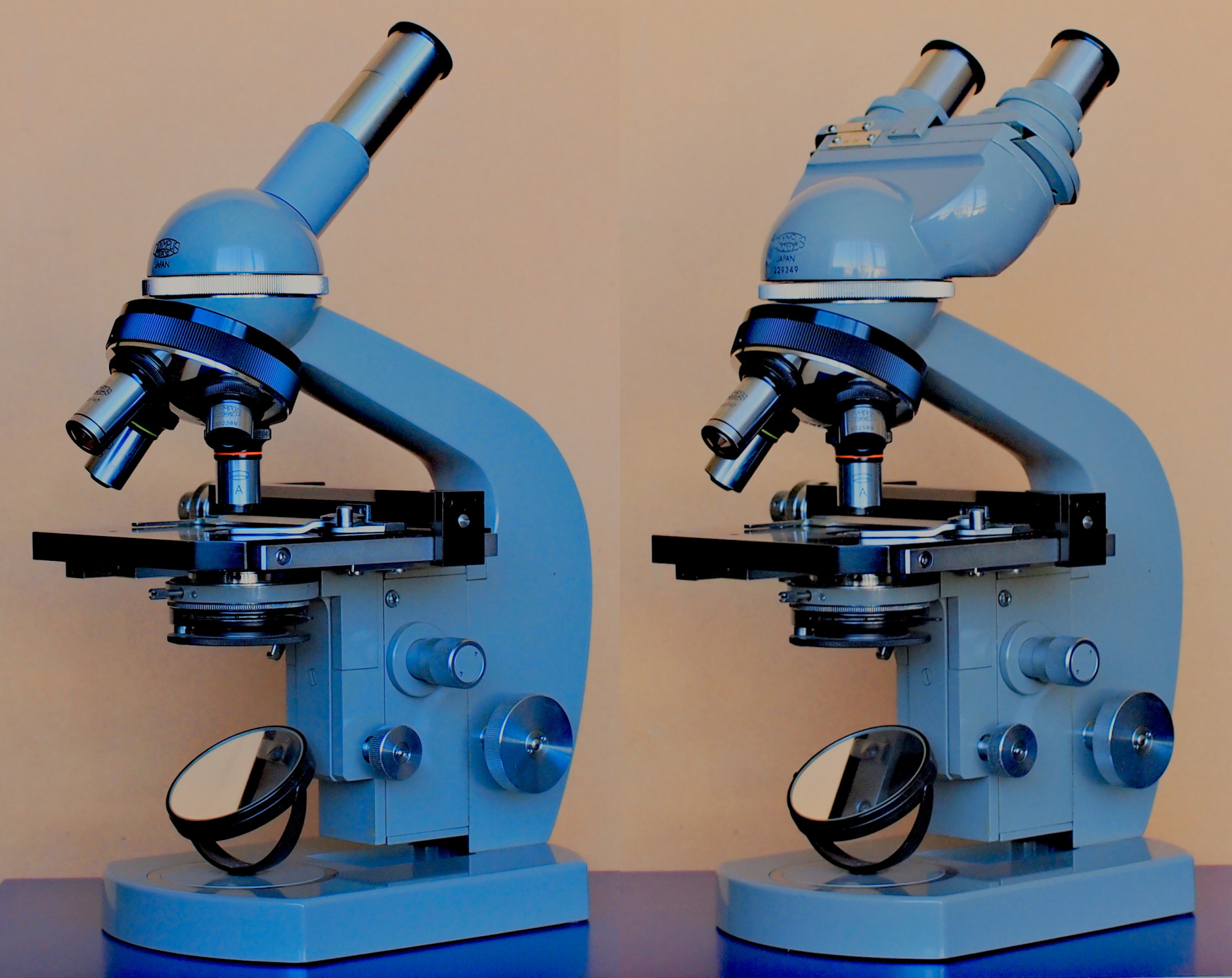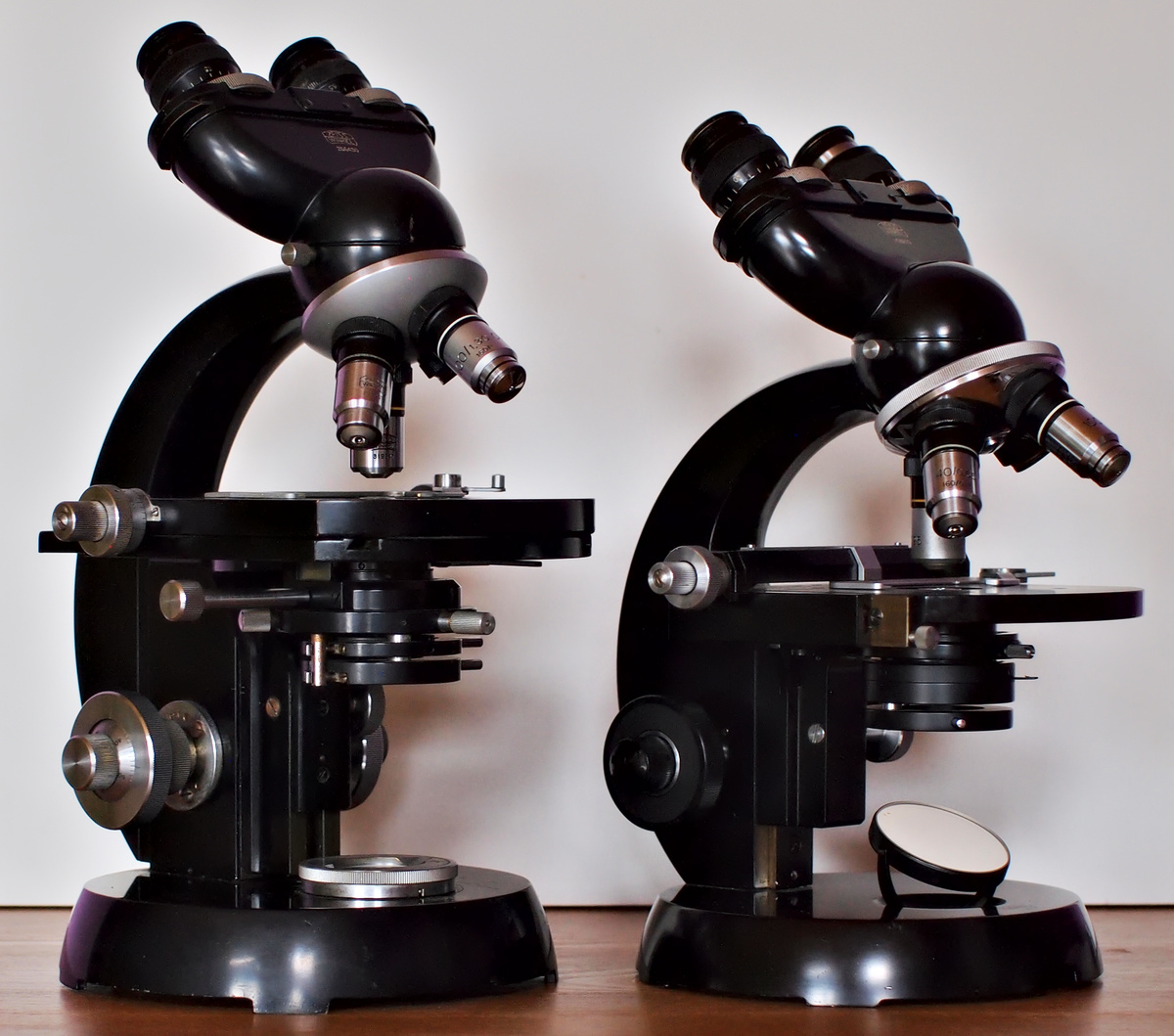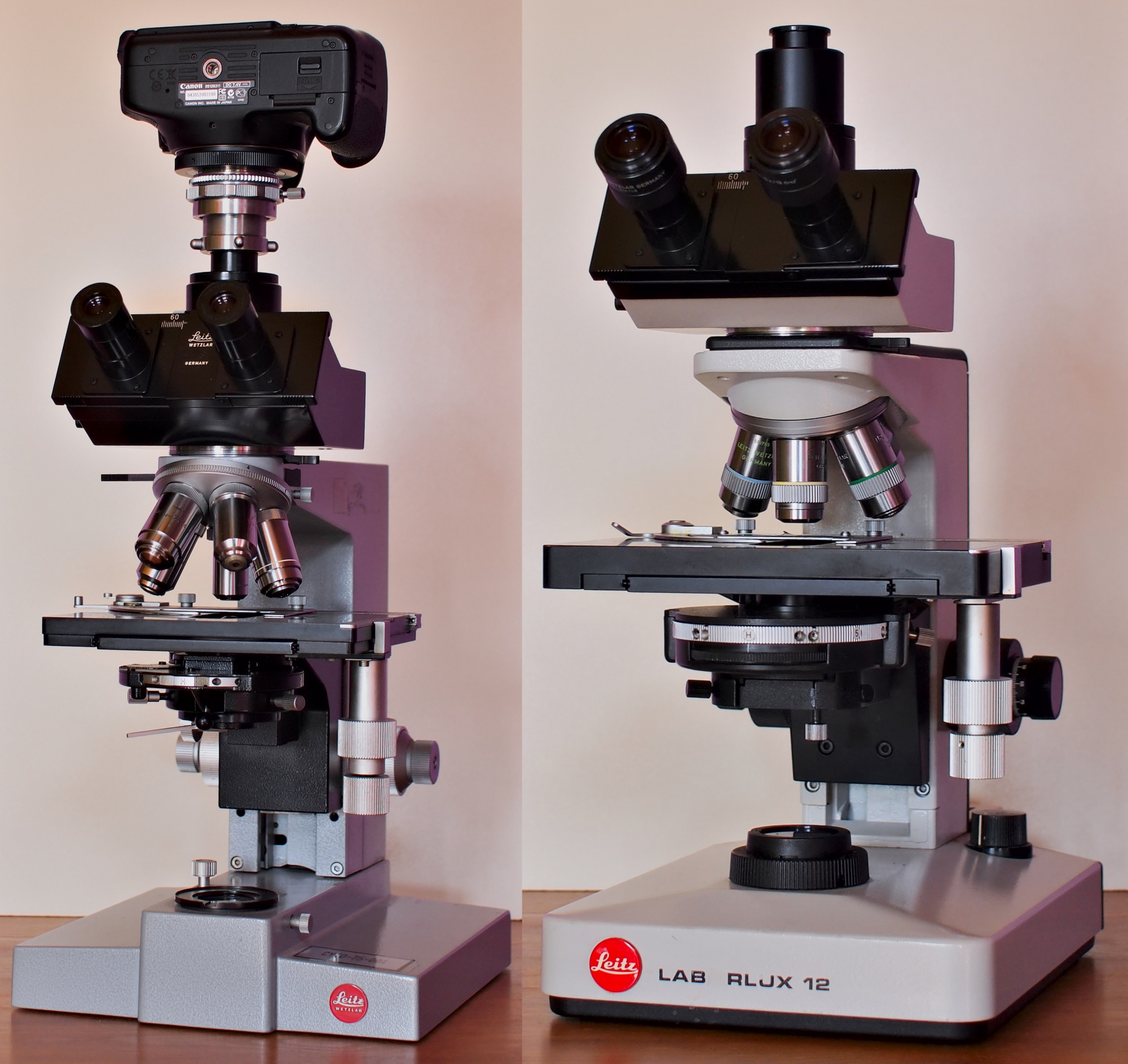If you have any plans purchasing a microscope, it is important to list a few things. The most important thing is to think about what you are going to observe with the microscope and which magnifications are required for this. In the microscopic world you have to deal with subjects that vary in size from roughly one micrometer to a millimeter, a 1000 fold difference. In a single drop of water from a ditch you can simultaneously find organisms that differ that much in size. Organisms with the above dimensions are observed with a biological microscope, also called transmitted light microscope.
Purchasing the first microscope
Everyone knows the classic microscope, the so-called horseshoe stand. Many people who followed biology classes in high school are familiar with them. They are monocular microscopes with a straight body tube and a horseshoe shaped base. These relatively simple microscopes are good to start with. For a beginner, it is not recommended to spend a lot of money on a first microscope, especially since many people do not know whether it will be a long lasting hobby. For some people, the initial interest may disappear after a short while. In that case, someone would want to sell the microscope again and the more expensive it was, the more difficult this will be. If someone starts with a simple and cheap microscope, it is easy to sell and to upgrade to a more advanced instrument when the interest in the hobby stays.
With microscopes, buying an older model on the second-hand market pays off. Many microscopes from the last century were very solidly build. The color of a microscope indicates the age. Brass microscopes are very old (1920s and older) and are in general less suitable to work with. These very old microscopes are more for the collector and they serve better as an ornamental object. The most suitable microscopes are black (roughly 1940s-60s) or gray (roughly 1970s). In these time periods very little or no plastic was used in microscopes. These microscopes are often made entirely out of metal and are quite heavy, which makes them mechanically robust and stable instruments. Today's new microscopes are generally of inferior quality. I have a strong preference for black microscopes. You don't get them any better than that and they are made of a quality that surpasses everything that is being produced today. Experienced microscope users sometimes say: "if it's not black, send it back!". But also many gray microscopes from the 1970s are very good. Like other optical instruments, a microscope does not age.
The used market is thus an interesting place to look for a first microscope. Quite some people have a microscope for sale that they don’t use anymore. Quite often however, the owner cannot tell whether the microscope is in good shape or he/she has little experience with it. But a horseshoe stand is mechanically and optically not that complex and this makes the chance of a defect somewhat smaller. There are a few things to keep in mind when looking for a used microscope:
● Avoid toy microscopes and the like. The used market offers quite some toy microscopes that look a lot like a real microscope. Older toy microscopes are often completely made of metal and at first sight they seem decent. By looking at the specifications written on the objectives and the height of the stand, it is quite easy to distinguish such a toy microscope from a genuine microscope. A real microscope has achromatic objectives on which specifications are written like mechanical tube length (mostly 160 or 170 mm), cover glass thickness (0.17 mm) and aperture (this value depends on the objective). For example, on a 40x objective the following may be written: 40/0.65, 160/0.17. Sometimes not all of these values are mentioned, but the aperture should always be indicated. And that is the value 0.65 in the example above. The objectives of toy microscopes lack these specifications and they will only be labeled with for example ‘40x’. These are not achromatic lenses but single lenses that give poor images that contain a lot of chromatic artefacts. The height of a real microscope (horseshoe stand) is at least approximately 30 cm. Toy microscopes with a horseshoe stand are always significantly smaller than that.
Microscopes with a built-in LCD screen or so-called ‘digital’ microscopes are most of the time a bad (and too expensive!) choice. Here too, no optical specifications are given, the built-in camera is poor and the resolving power is very low if any at all. It sounds so modern and appealing, such a 'digital' microscope. But a microscope is by definition not a modern and certainly not a digital instrument. It is a timeless optical instrument that has hardly been changed since the early 20th century.
● Mechanics. All mechanical parts must run smoothly. Mechanical parts include revolving nose-piece, slide holder, mechanical stage, coarse and fine focusing and condenser adjustment. A simple educational microscope may not have all these parts, but there should always be a nose-piece and coarse/fine adjustment. With microscopes that have not been used for a long time, some parts may have become stiff. Fortunately, with some lubrication, the mechanical parts of decent microscopes can mostly be put back into working order.
● Coarse and fine adjustment. It is important that these run smoothly. You can do little with a microscope of which the focusing adjustment does not work properly. The fine focusing adjustment can be checked by viewing a slide. If it doesn’t work, it is better to cancel the purchase. There are also microscopes that only have coarse adjustment, but these are more difficult to use at higher magnifications. It is therefore advisable to buy a microscope that also has fine adjustment.
● Stage. The slide is placed on the stage. The simplest version is a stage with holes for stage-clips and here the slide has to be moved with your fingers. This works well up to magnifications of approximately 200x, above which it becomes increasingly difficult to position the specimen precisely. A mechanical slide holder can usually be mounted in the holes of the stage, which makes moving the specimen a lot easier. The better microscopes often have a so-called mechanical stage that consists of 2 parts of which the upper part can be moved forward and backward and sometimes also sideways. Anyone who wants to work with higher magnifications should purchase a microscope with a mechanical slide holder or mechanical stage.
● Revolving nose-piece or turret. This is the revolving part that contains the objectives. Horseshoe stands usually have a nose-piece for 2, 3 or 4 objectives and sometimes there isn’t a revolving nose-piece at all and only 1 objective can be used. A microscope that can accommodate only 1 or 2 objectives is not very convenient to work with, so it is better to have a turret for 3 , 4 or more objectives.
● Optics. It is important that the image is sharp. If the image is blurry and cannot be brought into focus, there may be something wrong with the objective. If the image is sharp but has low contrast, than it is likely that the objective and/or eyepiece is dirty. The front lenses of eyepieces and objectives of used microscopes are quite frequently soiled, especially if you buy from someone who hasn’t have any knowledge about microscopes. Objectives and eyepieces can mostly easily be cleaned with distilled water that contains a few drops of dishwashing liquid.
● Objectives. For a beginner, a microscope with objectives 4/0.10, 10/0.25, 40/0.65 and eyepieces 5x (or 6x) and 10x will be sufficient. With this set of objectives and eyepieces, at least 90% of all microscopic subjects can be viewed in detail. A 100/1.25 oil immersion objective is not very useful for a beginner and even many experienced microscopists do not use this objective very often. On the other hand, an objective 20/0.40 or 25/0.45 is much more useful; this is a very convenient magnification which allows you to view many specimens in a pleasant way and with enough detail. Furthermore, a 20/0.40 or 25/0.45 objective has a pleasant working distance: there is a fair amount of space between objective and slide. For dark field microscopy, a 20x or 25x objective is ideal because it is very easy to obtain an impressive dark field image with this magnification. It is a very nice objective for observing pond life in brightfield or dark field illumination. Because it is not a standard objective, you usually won't find a microscope equipped with 20x-25x objective but it worth investing in it if you are really enjoying microscopy.
● Eyepieces. With a monocular microscope, it's useful to have several eyepieces with different magnifications so that a range of final magnifications can be obtained. More magnification isn't always better. In fact, the more the image is magnified, the blurrier it becomes. It's about resolving power, not final magnification. With a 40/0.65 objective, for example, using a 6x eyepiece results in a more brilliant and sharper image than when a 10x eyepiece is used. The resolving power remains the same with a lower magnification. Useful eyepiece magnifications for observation include 5x/6x, 8x, 10x, and 12.5x. Eyepieces with very high magnifications of 20x or more are sometimes offered online. Avoid these, as they ruin the image.
Eyepieces come in many shapes and sizes. Besides the simple Huygens eyepieces, there are also widefield eyepieces (often referred to as WF). These eyepieces provide a larger field of view, and you don't have to hold your eyes so close to them. Some people find these eyepieces comfortable to look through, others don't. So it's a matter of taste. Personally, I like using WF eyepieces with a binocular microscope, but not with a monocular microscope. I prefer a Huygens eyepiece if I have to look with one eye. The large field of view of a WF eyepiece distracts from the center, and it can sometimes be tiring to look at the edge of the field of view because you have to make larger eye movements. Some WF eyepieces have a very long eye relief (high eyepoint), meaning you have to hold your eyes quite far from the eyepieces. These can be used while wearing eyeglasses. But these eyepieces can also be tiring, as you're constantly adjusting your eyes' position relative to the eyepieces for the optimal distance. An example of this are the highly praised Carl Zeiss Kpl10xW eyepieces, which I find quite annoying to look through. At some point, a bit of a hype developed around WF eyepieces: the larger the field of view, the better. Let's be clear: a larger field of view doesn't always contribute to a better visual experience.
● Condenser. A condenser is a lens system under or in the stage that focuses the light on the specimen. In principle, a condenser is not necessary for small magnifications. However, with high power objectives, the condenser largely determines the resolution that can be achieved with a microscope. Simple student microscopes often have no more than a single lens in or under the stage and this works usually fine for objectives up to 40/0.65. However, some microscopes do not have an optical part at all that can act as a condenser. With some optimization by scattering the light with filters, good illumination can still be achieved. However, those who don't like this tinkering would be better off purchasing a microscope with a fixed or height-adjustable condenser. The latter is the best option. Most of the time, the condenser has a filter holder which is a very useful part in optimising illumination and for obtaining darkfield illumination.
● Monocular or binocular. Most horseshoe stands are monocular, only one eye is used. It has both advantages and disadvantages. For a beginner, however, I see more advantages than disadvantages because these microscopes are cheaper and optically less complex (so less chance of defects if you buy second-hand). In addition, some people have difficulties seeing through a binocular (with 2 eyes). Some people cannot merge the images from the two eyepieces into one field of view or they get a headache if the binocular head is not properly adjusted. It is also possible to view the image from a screen by using a good eyepiece camera, smartphone or DSLR camera so that you don’t have to look through the eyepiece. In that case, a monocular microscope is all you need. Viewing with one eye only can become tiring if the other eye is closed. The trick is to learn to observe with one eye while leaving the other eye open. Once you are used to this, you can conveniently look with one eye for longer times.
● Illumination. Older microscopes in particular often have a mirror, an underrated component. A mirror can provide very good lighting and it is possible to use any light source, from daylight to LED. In simpler microscopes, the built-in electric lighting is often of moderate to poor quality and an incandescent or halogen lamp can become so hot that you can burn your fingers on it. And if the lamp breaks, it is questionable whether it can be easily replaced. Built-in lighting is never a good idea because you are stuck with it and do not have the flexibility to quickly replace it with a better light source. If electric lighting is required, it is better to buy a microscope where the lamp is not built in and can be easily disconnected. A good and homogeneous illumination is very important for the quality of the image.
Horseshoe stands
Horseshoe stands are often sold cheaply on the second-hand market. These are microscopes that can only be expanded to a limited extent with accessories, but they are very functional, also for photography with system cameras. An advantage of a horseshoe stand is that it has an upright tube on which a heavier system camera can be placed. Some less heavier microscopes with an inclined tube can barely support an SLR camera without falling over. For attaching a camera, an upright tube is always preferred over an angled tube because with the latter, a camera puts tension on the tube due to the weight and the setup is much more sensitive to vibrations. Furthermore, with a horseshoe stand there is no prism between objective and eyepiece and that is definitely an advantage for photography (and also visual observation). Below are some microscopes that are regularly found on the second-hand market.
Olympus GB (left) and HSA (right), two high quality microscopes that can be found on the used market for little money. The GB is a very good and solid black horseshoe microscope which can also be used for professional work. Both high-resolution dark field microscopy and phase contrast microscopy are possible with it. The special condensers that are required for this fit in this microscope. The HSA, (not to be confused with the Olympus ST which has no fine adjustment), is a no-nonsense microscope. This is a compact student microscope with a fixed condensor.
Olympus HSC. On the left the matt gray version with mechanical slide holder and on the right the glossy gray version. Both with a height-adjustable condenser with aperture 1.25.
Classics from the past: Zeiss-Winkel (left) and Meopta (right). Both have a mechanical stage and a height-adjustable condenser.
Frequently offered horseshoe stands from Reichert (left) and Leitz (right). Both with a height-adjustable condenser and nosepiece for 4 objectives.
System microscopes
System microscopes are modular and can be expanded with many accessories. Parts for special illumination techniques such as phase contrast, dark field, fluorescence and polarisation are available for these microscopes. The visibility of certain objects can be greatly enhanced with these illumination methods. For example, phase contrast makes it easier to examine transparent objects that are difficult to see. Very small, colorless organisms such as bacteria are difficult to see with normal bright-field microscopy. Colorless objects that are transparent in bright-field are depicted black through phase contrast.
If you are going to look for a used laboratory microscope it may be wise to take someone along who has some experience with these types of microscopes. Unlike the simple horseshoe stands, these microscopes are mechanically and optically much more complex, so the bigger chance that something is not well adjusted or misaligned.
Olympus E
A good system microscope that is often found on the second-hand market is the Olympus E, a gray model from the 1970s. This is a very solid microscope and no plastic parts can be found on it.
Olympus E, monocular and binocular version. For this microscope, a good external Köhler lamp exists that can be mounted instead of the mirror.
The trinocular version is pictured here: Olympus model E.
Zeiss Standard
A system microscope that is often for sale on the used market is the so called Zeiss Standard. This is an all-round microscope that can be expanded with many accessories that are also quite easy to find. From the late 1950s to the 1980s, Carl Zeiss produced the Zeiss Standard microscope, a microscope suitable for medical routine and research purposes. This microscope became a household name in the medical world and can still often be found in current laboratories.
There are several different configurations of the Zeiss Standard. A few common types include the Standard GFL (older models are named Zeiss-Winkel Standard GF), Standard RA, Standard 14, Standard 16 and the smaller Standard Junior. All these models are suitable for the more ambitious hobbyist and for professional work and they can be expanded with the same accessories except for the Standard Junior. The Standard 14 and 16 were supplied with an external light bulb or built-in halogen lighting. A disadvantage of halogen lighting is that conversion to LED is more difficult and if the electrical circuit breaks, the question is if it can quickly repaired or replaced. A Standard model with a separate lamp (i.e. without built-in halogen lighting) is therefore preferred because the system can easily be equipped with LED lighting. Even a flashlight with the correct dimensions can be used in the lamp opening at the back, something that I often use during demonstrations at a location where there is no electricity nearby.
Warning: Delamination
A common problem with Zeiss Standard microscopes is the so-called delamination. This is the situation in which glued optical elements no longer adhere properly to each other because the sealant used for this becomes loose. Certain optical parts suffer more from it often than others. For example, the better corrected objectives and eyepieces from Zeiss are delaminated quite often. This mainly concerns CPL and Kpl-W eyepieces, Neofluar objectives, planapochromats and the so-called Siedentopf binocular tubes. Anyone who is looking for Zeiss planapochromats takes the risk of purchasing delaminated objectives. The planapo 4/0.16 for example, is almost always found in a delaminated state. Also Carl Zeiss DIC components mostly suffer from delamination. But that doesn't stop some DIC-obsessed people from paying high prices for a set of optical junk.
I can no longer recommend the later gray Zeiss Standards 14 and 16 with Siedentopf tube because I have seen delaminated parts on these microscopes far too often. The older Standard RA with sliding tube is a better choice, as is the even older black GFL/GF. It is good to realize that delamination is an ongoing process. This means that optics purchased now and in good condition may still be delaminated in a few years. I have experienced it myself regularly with Kpl-W eyepieces, Neofluar objectives and Siedentopf tubes, among others. Don't think that you are making a good investment by buying a Carl Zeiss planapochromate, because after a while, such a lens may have become defective and therefore worthless. The regular achromats, on the other hand, hardly suffer from delamination, so it is better to look for a microscope with these objectives.
When it comes to Zeiss Standard microscopes, a Standard 16 is often recommended, but I can no longer agree with that because of the above-mentioned problems. And of course, a Zeiss Standard 16 is an excellent microscope when everything is in order. But if your first microscope is a Standard 16 and you only find out much later that you actually bought an optical wreck, then even a no-name microscope without delamination would have been better.
Zeiss-Winkel
As for Zeiss Standard, my preference goes to Zeiss-Winkel who were the first to produce this microscope model. Delamination is not an issue here and I especially find the 40/0.65 achromats (this objective is used very much) better than those from Carl Zeiss. From Zeiss-Winkel there is the Standard GF and the Standard Junior. The Standard Junior is very compact and an excellent microscope to get started with. The Standard Junior fits the same tubes as the other Zeiss Standards, i.e. mono (both angled and straight), bino and trino. However, the Standard Junior has a different condenser holder than the Standard GF, but this can be used more easily for condensers from other brands. The older condensers for the Zeiss-Winkel Standard Junior had a numerical aperture of 1.2. This type of condenser allows for better darkfield illumination than a 0.9 NA condenser.
Zeiss-Winkel Standard GF (left) and Zeiss-Winkel Standard Junior (right). The Junior is shown here with a mirror which can easily be replaced by a lamp.
Leitz 170 mm and 160 mm systems
Leitz produced system microscopes of unprecedented quality in the 1970s and 1980s. The gray microscopes from the 1970s had a mechanical tube length of 170 mm. Microscopes that fall under this include the Orthoplan, Ortholux II and Dialux II. From the 1980s onwards, Leitz switched to a 160 mm mechanical tube length and we are talking about the more modern-looking white microscopes such as the Dialux 20 and Laborlux 12.
Leitz system microscopes are less often offered on the second-hand market than Zeiss and this also applies to the parts. Still, it is a better choice than Zeiss because the notorious delamination hardly occurs in Leitz optics. Moreover, I think the mechanical and optical quality of Leitz is slightly better than that of Zeiss.
Left: Trinocular version of the Leitz Dialux II with phase contrast condenser. A Canon 600D camera is mounted on the photo tube. Right: Leitz Laborlux 12 with 160 mm optics, backwards directed nosepiece and phase contrast condenser.
Buying new?
There are people who like to buy something that has not been used, i.e. new. There are plenty of new microscopes available on the internet. This mainly concerns Chinese microscopes that are provided with a name by an importer, they are importer brands. The fact that these are Chinese products is not the problem, Zeiss and Leica now also have the parts for their microscopes produced in China. But unlike Zeiss and Leica, there is little to no quality control with the importer brands. And that can cause unpleasant surprises such as poor optics, improperly adjusted mechanisms, rickety parts, a photo port of a trinocular tube that is not functioning well, etc. With microscopes for educational purposes and horseshoe stands, fewer problems are usually expected. There is less that can go wrong here, the chance of problems increases with the complexity of the microscope.
Anyone who wants to buy a new system microscope from a renowned brand such as Zeis, Leica, Olympus or Nikon (the 'big' 4) will have to pay a lot of money. A laboratory microscope with basic equipment easily costs a few thousand euros. If you want the cream of the crop, it is better to take out an extra loan because 10.000 euros will not get you there. That is the price you will have to pay if you want to buy a new microscope from one of the big 4 brands and which is comparable in terms of capabilities and equipment to the Leitz Dialux II described above.
With a new system microscope from an importer brand, you should not expect to get something that even comes close to the quality of, for example, a Leitz Dialux II for less than 2000 euros. But that does not mean straight away that you have a bad microscope. Euromex, for example, supplies pretty good microscopes. And Motic is a microscope manufacturer (not an import brand) that now also produces the optical parts for Zeiss.
